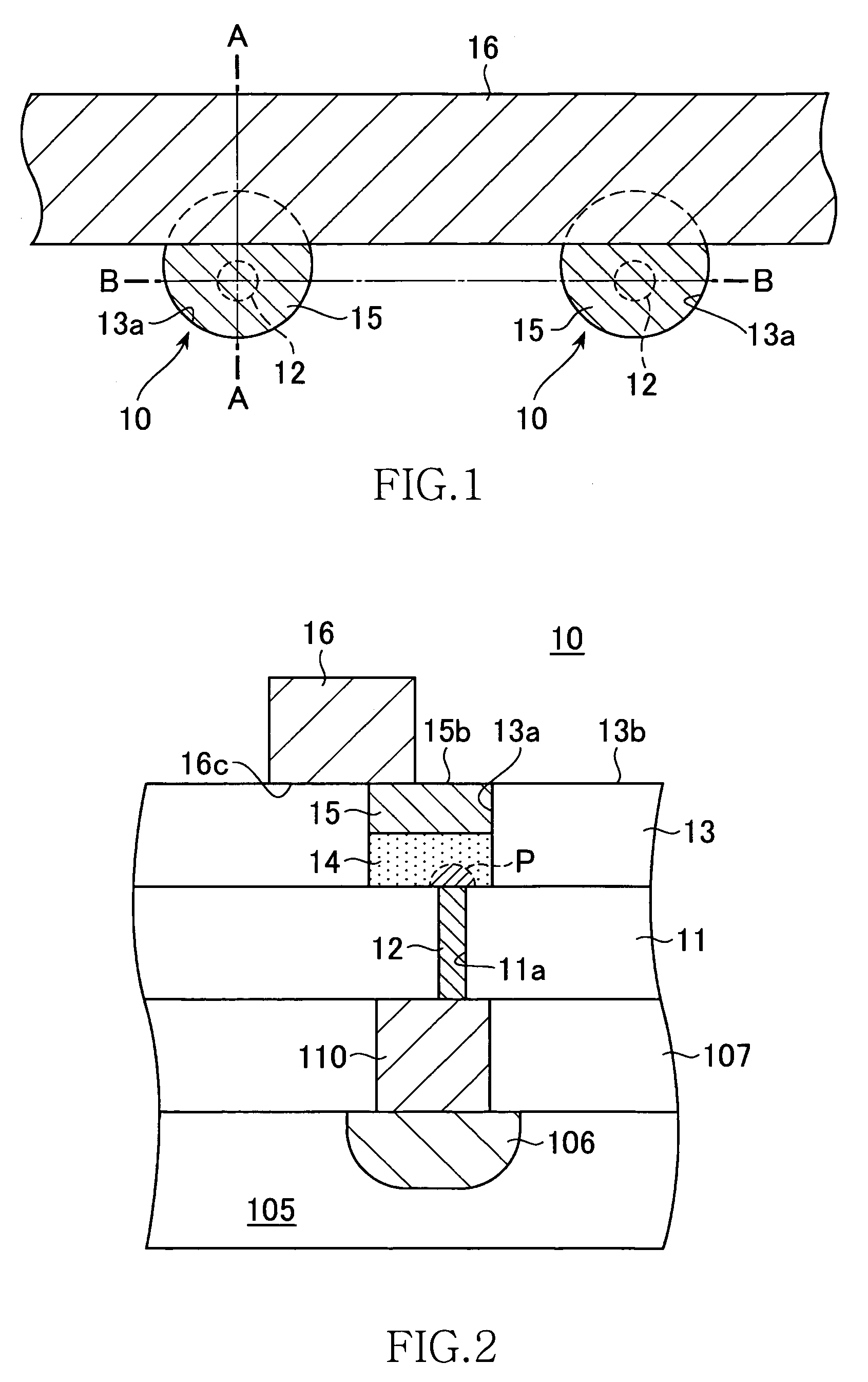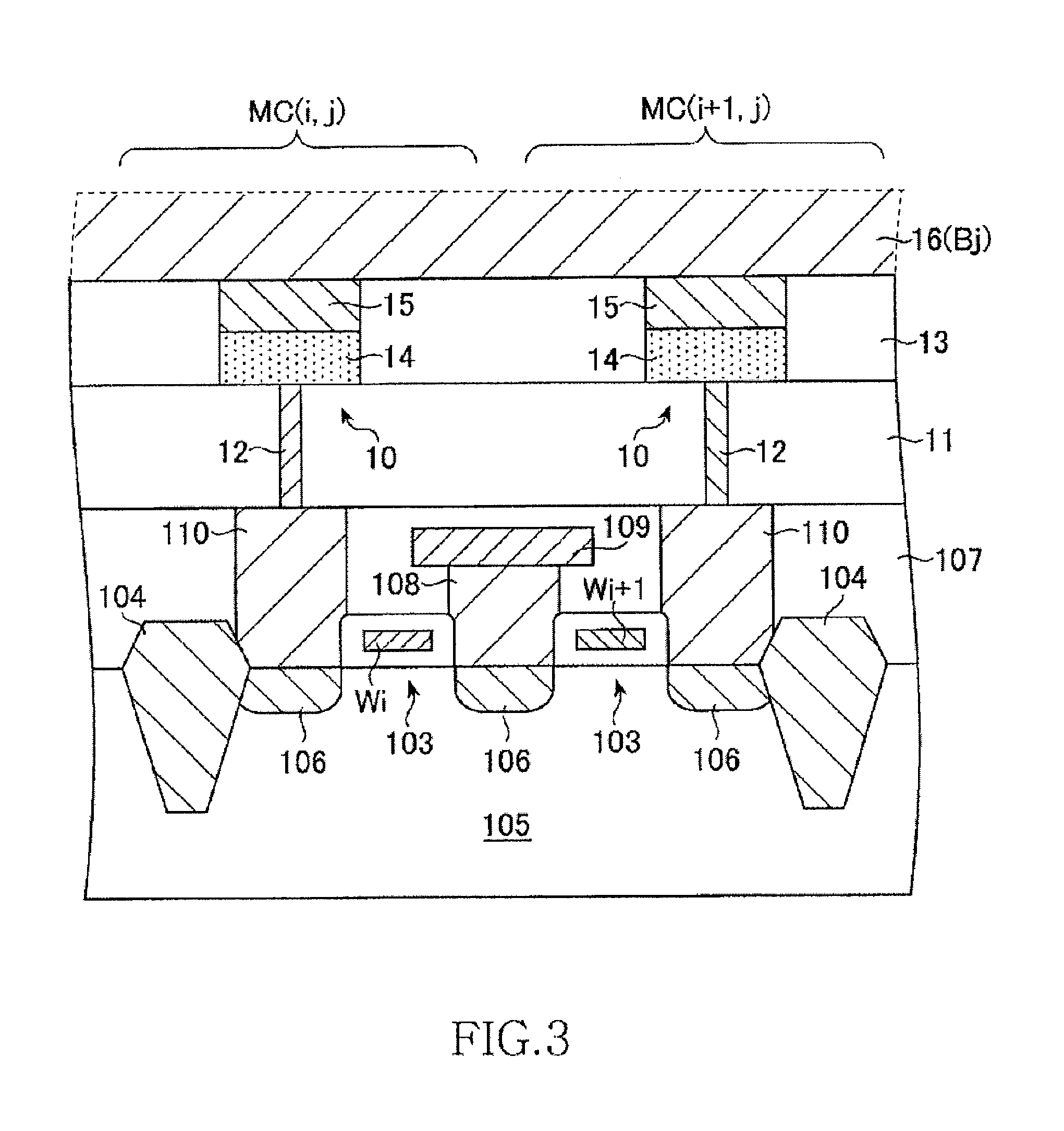Electrically rewritable non-volatile memory element and method of manufacturing the same
a non-volatile memory element, electric rewritability technology, applied in the direction of bulk negative resistance effect devices, electrical equipment, semiconductor devices, etc., can solve the problems of reducing the electrical power consumption of devices, dram is volatile memory that loses stored data, and the limit of device electrical power consumption, so as to reduce the contact area and suppress heat radiation to the bit line
- Summary
- Abstract
- Description
- Claims
- Application Information
AI Technical Summary
Benefits of technology
Problems solved by technology
Method used
Image
Examples
second embodiment
[0122]FIG. 17 is a schematic plan view of a structure of the non-volatile memory element 20 according to the present invention. FIG. 18 is a schematic cross section taken along a line E-E shown in FIG. 17. FIG. 19 is a schematic cross section taken along a line F-F shown in FIG. 17. FIG. 19 shows a structure of a memory cell that uses the non-volatile memory element 20 of this embodiment.
[0123]The non-volatile memory element 20 according to this embodiment is different from the non-volatile memory element 10 according to the first embodiment in that the inner portion of the through-hole 13a is formed with the recording layer 14 alone, and the upper electrode 15 is formed on the interlayer insulation film 13. The remaining respects of the non-volatile memory element 20 are the same as those of the non-volatile memory element 10 according to the first embodiment. Thus, like reference numerals denote like parts, and redundant explanations thereof will be omitted.
[0124]In this embodimen...
third embodiment
[0137]FIG. 24 is a schematic plan view of a structure of the non-volatile memory element 30 according to the present invention. FIG. 25 is a schematic cross section taken along a line G-G shown in FIG. 24. FIG. 26 is a schematic cross section taken along a line H-H shown in FIG. 24. FIG. 26 shows a structure of a memory cell that uses the non-volatile memory element 30 according to this embodiment.
[0138]The non-volatile memory element 30 according to this embodiment is different from the non-volatile memory element 10 according to the first embodiment in that side surfaces of the recording layer 14 and the upper electrode 15 are not covered with an interlayer insulation film but are covered with a sidewall insulation layer 31. The remaining respects of the non-volatile memory element 30 are the same as those of the non-volatile memory element 10 according to the first embodiment. Therefore, like reference numerals denote like parts, and redundant explanations thereof will be omitted...
first embodiment
[0139]In this embodiment, the bit line 16 is formed so as to cover one portion of a boundary line between the upper electrode 15 and the sidewall insulation layer 31, as shown in FIG. 25. That is, the bit line 16 is formed so that the edge thereof traverses the upper electrode 15. Thus, one portion of the bottom surface 16c of the bit line 16 contacts one portion of the top surface 15b of the upper electrode 15. The remaining portion thereof contacts the sidewall insulation layer 31 and the interlayer insulation film 11. The remaining portion of the top surface 15b of the upper electrode 15 does not contact the bit line 16. Thus, in this embodiment, similarly to the first embodiment, the bit line 16 is arranged to be offset to the recording layer 14. As a result, a contact area between the bit line 16 and the upper electrode 15 is reduced, and the distance between the phase change region P and the bit line 16 can be increased.
[0140]A manufacturing method of the non-volatile memory e...
PUM
 Login to View More
Login to View More Abstract
Description
Claims
Application Information
 Login to View More
Login to View More - R&D
- Intellectual Property
- Life Sciences
- Materials
- Tech Scout
- Unparalleled Data Quality
- Higher Quality Content
- 60% Fewer Hallucinations
Browse by: Latest US Patents, China's latest patents, Technical Efficacy Thesaurus, Application Domain, Technology Topic, Popular Technical Reports.
© 2025 PatSnap. All rights reserved.Legal|Privacy policy|Modern Slavery Act Transparency Statement|Sitemap|About US| Contact US: help@patsnap.com



